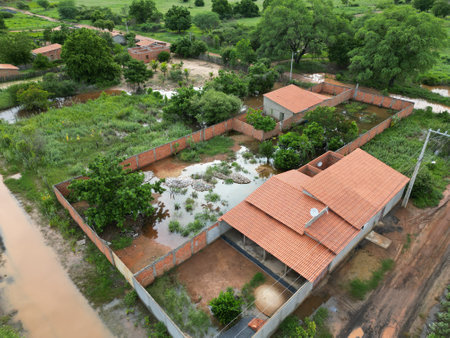Understanding Traditional Indian Village Construction Methods
Traditional Indian villages are rich in construction wisdom, handed down through generations and closely tied to the environment. The methods used for building homes and community spaces in these villages reflect a deep understanding of local climate, available resources, and cultural values. One of the most crucial elements in this indigenous approach is the careful selection of soil for construction. In many regions across India, villagers use mud, clay, laterite, or a combination of these materials to build walls, floors, and even roofs. The choice of soil is not only a matter of structural integrity but also holds significant cultural importance. For instance, specific soils are believed to bring prosperity or health, and rituals often accompany the gathering and preparation of earth for building. Furthermore, the right type of soil ensures that homes remain cool in the summer and warm in the winter, providing natural comfort without reliance on modern technologies. Understanding these traditional techniques helps us appreciate the sustainable practices that have shaped rural India for centuries and underscores why soil selection remains at the heart of village construction.
Types of Soils Commonly Found in Rural India
When planning for construction in traditional Indian villages, understanding the types of soils prevalent in rural regions is crucial. The diversity of soil types across India directly influences the durability and suitability of village structures. Below is an overview of the primary soils found in rural India, their characteristics, and their typical locations.
| Soil Type | Main Characteristics | Geographical Distribution |
|---|---|---|
| Alluvial Soil | Rich in nutrients, good drainage, easy to work with, moderate strength for mud construction. | Ganga-Brahmaputra plains, northern and eastern India (Uttar Pradesh, Bihar, West Bengal, Assam). |
| Black Cotton Soil | High clay content, retains moisture, prone to swelling and shrinking; requires special treatment for foundations. | Deccan Plateau region – Maharashtra, Madhya Pradesh, Gujarat, parts of Andhra Pradesh and Karnataka. |
| Red Soil | Poor in lime and humus but well-drained; suitable for adobe or rammed earth when stabilized with straw or cow dung. | Tamil Nadu, Karnataka plateau, eastern Andhra Pradesh, Chhattisgarh, parts of Orissa and Jharkhand. |
| Laterite Soil | Porous and easily workable; can be cut into bricks after drying. Requires stabilization for load-bearing walls. | Western Ghats (Kerala, Karnataka), parts of Odisha and West Bengal. |
| Sandy Soil | Low cohesion and bearing capacity; generally mixed with clay or organic matter for construction use. | Rajasthan desert area, parts of Haryana and Punjab. |
Understanding these soil types is essential for selecting proper building techniques that have been time-tested by Indian villagers over generations. For example, black cotton soil may require deep foundations or stone platforms to prevent cracking of mud walls during monsoon swelling. On the other hand, alluvial soils are often preferred for cob or mud house construction due to their balanced properties. Local wisdom dictates not only the choice of soil but also the season for starting construction activities — often post-monsoon when soil moisture content is ideal for moulding bricks or plastering walls. By respecting these regional variations in soil quality and tradition, builders can ensure longevity and comfort in village homes while honouring cultural heritage.

3. Key Factors in Choosing Suitable Soil
When it comes to constructing homes and other structures in traditional Indian villages, selecting the right soil is a matter of both cultural wisdom and practical necessity. Village builders have long relied on their knowledge of local soil characteristics to ensure that houses remain stable, comfortable, and enduring through generations. There are several key factors that must be considered when choosing suitable soil for construction in this unique context.
Moisture Retention
One of the most important considerations is moisture retention. In many regions across India, especially in areas prone to monsoon rains or extended dry periods, the ability of soil to retain or drain water directly impacts the durability of mud walls and floors. Too much moisture can lead to structural weakening or erosion, while too little can cause cracking and instability. Traditionally, villagers test soil by making small balls and observing how they hold together after drying in the sun—a time-tested method to assess optimal moisture content for building purposes.
Compaction Ability
The compaction property of soil determines how well it can be packed down to form strong foundations and walls. Good compaction reduces air gaps within the soil, minimizing the risk of subsidence over time. In rural settings, compacted earth floors and wall bases are often created using simple tools like wooden pestles or even livestock hooves, reflecting both resourcefulness and respect for indigenous techniques.
Bearing Capacity
Bearing capacity refers to the soil’s ability to support the weight of structures without excessive settling or shifting. Traditional Indian village homes are typically single-storey with thick earthen walls, so moderate bearing strength is usually sufficient. However, soils heavy with clay may expand during rains and shrink during dry spells, leading to cracks. Sandy soils, on the other hand, may lack cohesion unless mixed with stabilizers like cow dung or lime—materials commonly used in rural construction for centuries.
Local Adaptations and Community Knowledge
Village elders and masons often possess invaluable knowledge about which soils work best for various types of buildings—from homes and kitchens to grain stores. They take into account not only technical factors but also local climate patterns, availability of organic additives, and traditional rituals that promote harmony between built structures and the surrounding land.
Conclusion: Integrating Tradition with Practicality
In summary, choosing the right soil for construction in traditional Indian villages involves a thoughtful examination of moisture retention, compaction ability, bearing capacity, and local experience. These factors combine to create buildings that are both resilient and culturally meaningful—an approach worth preserving as villages continue to evolve alongside modern development.
4. Traditional Practices and Rituals in Soil Selection
Across the diverse regions of India, traditional villages have long relied on a blend of age-old customs, spiritual beliefs, and collective wisdom for choosing the right soil for construction. This process is deeply rooted in local culture and reflects a holistic approach that goes beyond mere physical properties. Elders and artisans often guide soil selection based on time-tested rituals that have been passed down through generations.
Role of Community Elders and Artisans
In many Indian villages, the decision to select construction soil is not made by individuals alone but involves consultation with community elders and skilled masons (known locally as mistris). These experts possess invaluable knowledge about the land, its history, and its suitability for various structures. Their involvement ensures that both practical aspects and cultural nuances are respected.
Customary Soil Testing Methods
Before modern science introduced laboratory testing, villagers used simple yet effective methods to test soil quality. Some of these include:
| Customary Test | Description | Cultural Significance |
|---|---|---|
| Smell & Taste Test | A pinch of soil is tasted or smelled to detect impurities or excess salts. | Symbolizes the close connection between people and their environment. |
| Water Jar Test | Soil is mixed with water in an earthen pot; clear separation indicates good quality. | Reflects belief in nature’s indicators as signs from the earth goddess (Bhoomi Devi). |
| Ant Nest Observation | If ants build nests in certain soil types, it’s considered fertile and stable. | Shows respect for animal behavior as wisdom from nature. |
Beliefs and Rituals: Spiritual Dimensions
Soil selection ceremonies are often accompanied by rituals seeking blessings from local deities or ancestors. Villagers may offer flowers, turmeric, rice, or coconut at the site before digging begins. Such practices are believed to ensure harmony with the land and protection from negative energies throughout the building process.
Preserving Indigenous Knowledge for Future Generations
The reliance on traditional practices emphasizes sustainable building while fostering a sense of community ownership over village development. By honoring these customs, present-day villagers not only preserve their heritage but also maintain ecological balance—a principle central to Indian rural life.
5. Comparing Traditional and Modern Soil Assessment Methods
In the context of Indian villages, soil selection for construction has always been a matter of practical wisdom handed down through generations. Traditionally, local artisans and elders would assess soil by touch, smell, and visual cues—looking for specific colours or textures that indicate stability and fertility. For example, red and yellow soils are often preferred due to their strength and resistance to waterlogging, while black cotton soil is generally avoided because of its high shrink-swell capacity during monsoons.
Today, modern engineering brings scientific methods such as soil sampling, laboratory tests for bearing capacity, and moisture content analysis. These advanced techniques offer precise data that can enhance safety and durability. However, in many Indian villages, there remains a harmonious blend of both approaches. Local builders may initially rely on traditional assessments but increasingly consult engineers for critical projects or when new materials are involved.
This blending of tradition and technology creates a unique construction culture. It respects the ecological knowledge embedded in village customs while embracing innovations that improve resilience against earthquakes or floods. In some regions of Kerala or Rajasthan, for instance, villagers still test soil by rolling it between their fingers to gauge clay content before confirming findings with professional equipment.
The contrast between these methods is not merely technical—it reflects broader social dynamics. Where resources are limited, traditional practices prevail out of necessity and trust in ancestral wisdom. Conversely, government-funded projects or urbanising villages are more likely to implement comprehensive geotechnical surveys.
Ultimately, the right approach depends on local conditions and project scale. The fusion of indigenous insight with scientific rigour ensures that construction in Indian villages remains both rooted in heritage and equipped for the future.
6. Challenges and Sustainable Approaches in Soil Use Today
As Indian villages continue to develop, the traditional practices of soil selection and usage face several contemporary challenges. Soil erosion remains a critical issue, especially during the monsoon season when heavy rainfall can wash away fertile topsoil. This not only affects the quality of the land for farming but also impacts the availability of suitable soil for construction purposes. Additionally, overuse of agricultural land due to increased population pressure has led to soil degradation, making it harder for villagers to find the right type of earth for their homes and community structures.
Sustainable Farming and Construction Practices
Today, there is a growing awareness among rural communities about the need for sustainable approaches to soil use. Many villages are returning to traditional crop rotation and organic farming methods, which help maintain soil fertility and structure. These practices ensure that the same piece of land can yield both good crops and high-quality mud for building over generations. In some regions, local panchayats and NGOs actively promote these methods through workshops and practical demonstrations.
Innovative Solutions for Modern Villages
At the same time, innovative techniques such as rainwater harvesting and controlled irrigation are being adopted to combat soil erosion. The use of natural barriers like vetiver grass along field boundaries helps hold the soil together during heavy rains. For construction, villagers are exploring blends of traditional mud with stabilizers like lime or cow dung, which not only strengthen village homes but also extend their lifespan without harming the environment.
The Road Ahead: Balancing Tradition and Progress
The challenge for today’s Indian villages lies in striking a balance between age-old wisdom and modern needs. By embracing sustainable practices rooted in India’s rich cultural heritage—such as conserving topsoil, practicing mixed cropping, and using local materials—villagers can continue to build strong, eco-friendly homes while preserving their land for future generations. As more communities share knowledge and success stories across regions, these sustainable approaches offer hope for resilient village life in a rapidly changing India.


